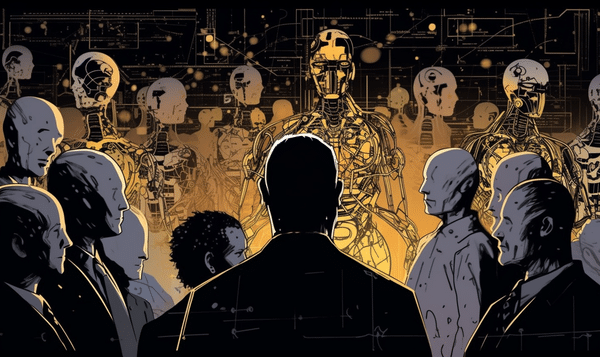“Back to the future” may be an overused cliché, but it couldn’t be more apt for the marketing world today. Generative AI models are taking us back to the basics, revolutionizing the way marketing campaigns are created and executed. Remember the days when a concise brief was your starting point for any campaign? Well, you can now type your ideas into an AI-powered tool and get creatives in seconds, bringing marketing assets to life as quickly as you can think of them.
Take Dall-E, for example, which creates captivating images based on marketing themes and ideas. And Adobe’s Firefly, which not only generates variations of specific design elements but also creates paintbrushes based on existing images. The launch of these powerful tools follows Adobe’s $20 billion acquisition of design platform Figma, further solidifying the company’s dominance in the creative space.
The generative AI landscape has experienced rapid growth since the explosive debut of OpenAI’s ChatGPT, with companies like Stable Diffusion joining the fray. However, these remarkable tools have not been without their share of ethical concerns, such as “hallucinating” inaccurate information or stealing artist content without credit or permission.
Adobe aims to address these concerns with Firefly, emphasizing opportunities for creators to benefit from their skills and protect their work. While the generative AI technology is impressive, it’s important to recognize that it excels in some tasks more than others.
As Benedict Evans noted on Twitter, “A 20% error rate in a text generator is ‘this thing is telling lies and making stuff up’ – but a 20% error rate in an image generator is ‘I’m not quite sure where the door is, but honestly who cares when it looks like that.'” Former Windows boss Steven Sinofsky echoed this sentiment, stating that generative technology should focus on creative tasks until sourcing and verification issues are addressed.
So, where does generative AI shine? Here are three areas where it’s already proving valuable:
Creative tasks: Programs like Dall-E 2, Stable Diffusion, and Adobe’s Firefly are revolutionizing how movies, video games, and other creative works are produced. These tools serve as a launchpad for human creativity, sparking new ideas and concepts. However, the technology does raise legal and ethical issues related to copyright, training data biases, and perpetuation of stereotypes.
Genre shifting: Text generators like OpenAI’s GPT-4 excel at transforming data into various formats, from summarizing meeting notes to crafting press releases or social media content. For a lighter touch, tools like ChatGPT and Google’s Bard can transform information into poems, raps, and other creative expressions.
Experimenting: Despite limitations and drawbacks, experimenting with AI now helps us understand its capabilities and potential. Companies like Microsoft, Google, OpenAI, and Adobe are publicly testing various tools, offering opportunities for civil rights groups, regulators, and individuals to provide feedback and address concerns.
As generative AI continues to improve, it will likely tackle tasks it currently struggles with and integrate seamlessly with companies’ data and intellectual property. Firms like Salesforce, Microsoft, and Google are already pitching today’s technology for various applications, with even more ambitious future uses on the horizon. For now, companies tend to use these tools to “draft” text and code, allowing human oversight to modify suggestions before they go live. Microsoft refers to its workplace tools as “copilots,” while others adopt a similar collaborative approach.
In certain contexts, AI can augment overworked professionals and even address shortages in critical fields. For example, online education service Khan Academy is testing a tutoring system built on top of GPT-4. Founder Sal Khan believes AI can not only help raise the quality of education in developing countries but also provide support for students in wealthier nations when they need it most.
Bill Gates, in a recent op-ed, compared the impact of AI to the graphical user interface’s revolutionary effect in the 1980s. He envisions AI leading to massive changes across various sectors, such as health care, where it can accelerate medical research and improve primary diagnoses. Gates acknowledges the potential for misdiagnoses but argues that the benefits of AI in health care outweigh the risks.
In the workforce, Gates predicts AI will serve as a “personal agent,” drafting emails, managing schedules, and taking notes. Although this shift will necessitate governments to support workers transitioning into new roles, Gates argues it will allow humans to focus on areas where software falls short, such as patient care and elderly support.
Education is another area where AI is making waves, with students using it for homework and writing assignments, and teachers employing it for lesson planning. Gates sees AI as a crucial educational tool that can adapt to students’ understanding and motivation levels.
However, generative AI also brings potential harms. Issues like misinformation , hate speech, and emotional manipulation have surfaced as these AI models gained popularity. Gates acknowledges the misinformation problem and asserts that limitations like ChatGPT’s struggles with abstract reasoning may be resolved within a couple of years.
To ensure that AI doesn’t exacerbate existing inequalities, Gates emphasizes the need for intervention from governments and organizations. He argues that AI should be used to “help the poorest” and reduce inequality, and that policymakers and philanthropists should prioritize such efforts.
Looking further ahead, Gates mentions the emergence of superintelligent AIs, machines capable of surpassing human intelligence and making autonomous decisions. While the impact of these superintelligent AIs on society remains uncertain, Gates remains excited about their potential.
In the meantime, Gates urges the continued adoption of AI technology alongside the establishment of guardrails and regulations. “This new technology can help people everywhere improve their lives,” he writes. “At the same time, the world needs to establish the rules of the road so that any downsides of artificial intelligence are far outweighed by its benefits.”
Generative AI is poised to revolutionize marketing and numerous other industries. While it offers incredible potential for creativity and productivity, it also raises ethical and practical concerns that require careful consideration. As we continue to explore this brave new world of AI-driven marketing, we must strike a balance between embracing the creative revolution and addressing the challenges of opening Pandora’s Box










